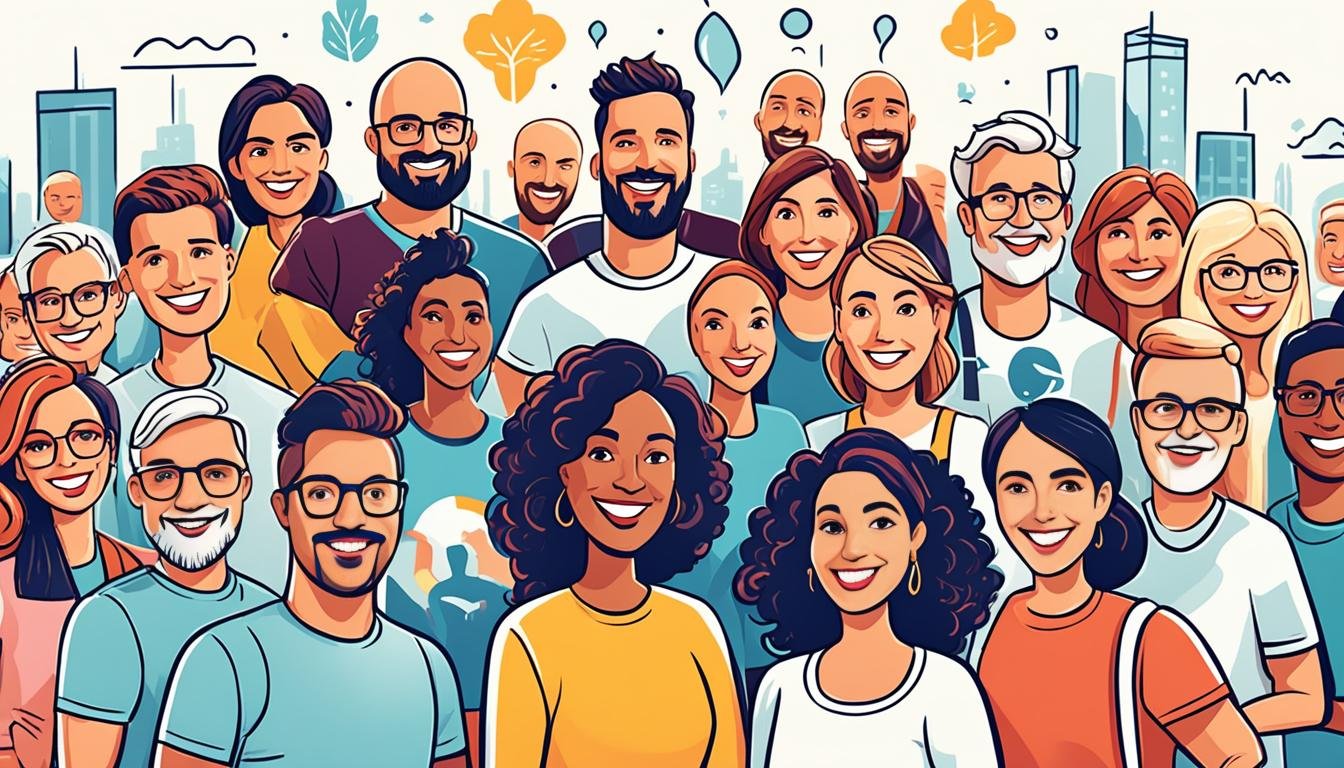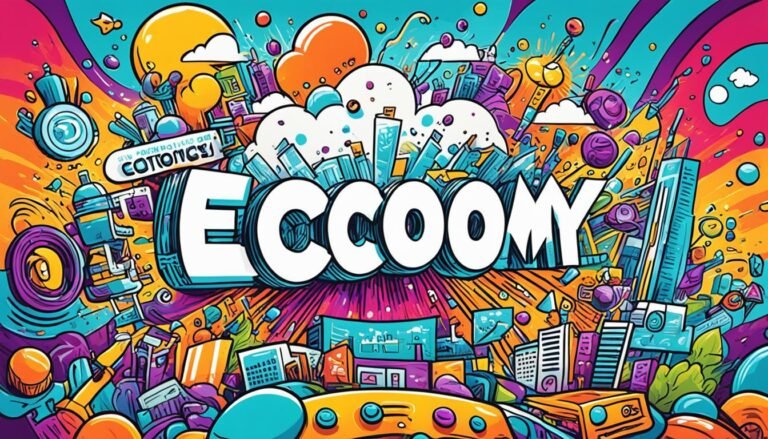The Network Effect: Building a Strong Community
In 2021, Facebook made a huge $43.39 from each user, bringing in $13.89 in profits per user. This is thanks to the network effect. It’s key for building strong communities online for businesses and platforms.
Big names like Amazon and Meta, and even smaller ones like Airbnb, know how important the network effect is. For example, Meta’s Threads quickly got 100 million users, showing how fast a community can grow.
Amazon didn’t just start as a bookstore; it became a giant thanks to the network effect. It grew into many product areas and even launched AWS for cloud services. Alphabet also saw its market cap hit $1.5 trillion, mainly because Google’s user base grew fast.
These stories show how powerful the network effect can be in creating lasting online communities. Airbnb is a great example. It gets more valuable as more people join, showing how a well-built community can help everyone involved.
Key Takeaways
- The network effect is crucial for building strong communities in tech and business.
- Facebook’s success shows the big financial benefits of having a strong user network.
- Amazon and Alphabet’s huge market values come from using the network effect well.
- Platforms like Airbnb get more valuable as more people join.
- Meta’s Threads grew fast thanks to the network effect.
Understanding the Network Effect
The network effect is key to the growth and success of many platforms and businesses. It means a product or service gets more valuable as more people use it. Technology companies use this effect a lot to grow their businesses and plan their strategies.
Definition of the Network Effect
Network effects make a product or service more valuable as more users join. Experts like Michael Katz and Carl Shapiro explain that platforms become more useful as more people use them. Without many users, a platform is not very useful. But, as more people join, it gets better and more useful for everyone.
Social media sites like Facebook and Twitter are great examples. Users create and share content, making the platform better for everyone. This makes more people want to join, creating a cycle of growth. Games also get better for players as more people join, showing how network effects work.
Importance in Technology and Business
Network effects are very important in technology and business. Companies use strategies to make the most of these effects and grow. When done well, companies can beat their competitors and lead the market.
Facebook grew to have 2.89 billion users by Q2 2021, thanks to network effects. This growth helped the company make a lot of money, with a 56% increase in revenue to $29.08 billion.
But, there are risks too. Too many users can make a platform worse, like what happened to Twitter. Managing network effects well is key to keeping users happy and growing.
Companies like Amazon have thrived by using network effects smartly. They’ve become a big part of the U.S. online market, beating competitors. By listening to users and growing their user base, they show how strong platform strategies can change the game.
Historic Examples of the Network Effect
The network effect has played a key role in the growth of many industries. By looking at telecommunications, railways, and early computing and social networks, we see how more users have driven value. This shows how the more people use a service, the more valuable it becomes.
Telecommunications: Phones and Land Lines
Robert Metcalfe introduced Metcalfe’s Law in telecommunications. It says the value of a network grows with the square of its users. Early phone networks got more valuable as more people joined, creating a strong communication system for everyone.
Today, mobile networks keep growing because more people use them. This idea is still true, making mobile networks more valuable as they get more users.
Railways and Transportation
The growth of railways is another great example. As more lines were built and more people used them, the network got better. This helped share goods and services over wider areas, boosting the economy and cities.
Early Computing and Social Networks
The early days of computing and social networks show us the network effect in action. Sites like Facebook, YouTube, and Instagram grew fast as more people joined. Companies like Meta and Apple used this growth to succeed.
Social media became key for talking and doing business. Companies that used these networks well could lead their markets.
The network effect has been key in many areas, showing that more users mean a more valuable network. This is true for telecommunications, railways, and social networks. The idea is simple: more users make the network more valuable.
How Tech Companies Leverage the Network Effect
Tech giants have mastered the network effect to grow fast and lead their markets. They know how to make value by connecting people. Companies like Facebook and Uber show how big an impact this has on tech businesses.
Case Study: Facebook
Facebook is a perfect example of the network effect. It grew by adding more users, making the social experience better for everyone. This cycle brought more users, making Facebook a giant in social media.
Facebook Messenger uses personal network effects to bring in users and improve daily chats. Starting free, Facebook quickly gained users, then made money through various strategies.
Case Study: Uber
Uber’s story shows the power of the network effect too. More riders and drivers made the service better and more reliable. This led to shorter waits and better routes, making everyone happier.
Uber’s network also helps indirectly. More drivers mean more riders, and vice versa. This shows how growing the network can make the service better and users happier.
Monetizing the Network: Advertising and Data
Advertising and data analytics are key to making money for these companies. Facebook uses its huge user base to draw in advertisers. It targets ads to users, creating a strong ad market. Uber makes money through different ways, like changing prices and working with other services.
Both companies show how the network effect can lead to more users and big profits.
Direct vs Indirect Network Effects
There are two main types of network effects: direct and indirect. Knowing the difference helps us see how platforms grow fast.
Understanding Direct Network Effects
Direct network effects happen when more users make a platform better for everyone else. This is true for social media and online communities. For example, Facebook got more valuable as more people joined, making it easier to stay in touch.
https://www.youtube.com/watch?v=K74_FNnlIF8
eBay is another example. More buyers and sellers make the marketplace better for everyone. LinkedIn also grows as more professionals join, helping job seekers and recruiters.
Understanding Indirect Network Effects
Indirect network effects mean growth in one area helps another area. Uber is a great example. More users mean a better experience for drivers, which attracts more drivers and benefits riders.
This creates a positive cycle, making services or products better. Reaching a certain point is key – when joining is more beneficial than not, growth speeds up.
Complementary Network Effects
Complementary effects happen when products or services linked to a platform become more valuable. LinkedIn’s growth makes it more useful to recruiters, which attracts more job seekers. This shows how connected products can grow together and improve the network.
In summary, knowing about direct, indirect, and complementary network effects is key to using platforms well. Companies like Facebook, Uber, eBay, and LinkedIn use these effects to grow and lead in the market.
Building a Strong Community: The Network Effect in Action
Building a strong community is more than just having lots of people. It’s about getting everyone involved and keeping them interested over time. Good community management means keeping people engaged and growing, while also keeping the community feeling like a home.
Essential Community Elements
A strong community needs a few key things:
- Active Participation: Getting members to share their thoughts, resources, and connections builds a strong community.
- Diverse Contributions: Having a mix of contributions, like different ideas and actions, makes the community richer.
- Leadership and Influence: Having influential members can help push the community towards its goals, as seen in places like Adams County and Norwalk.
Increasing User Engagement
Getting people involved is key to good community management:
“Bringing the right people together to achieve goals is essential,” stressed Sarah Hughes, a Civic Influencer. The success stories from Norwalk ACTS and the Rocky Mountain Partnership show how working together makes a difference.
Also, giving community members the tools to understand and fight against disparities helps keep them engaged. The Rocky Mountain Partnership’s Civic Influencer strategy helped over 20,000 students, showing how empowering people can make a big impact.
Balancing Growth and User Retention
It’s important to balance community growth with keeping members around. Studies like Zipf’s Law and the ¾ scaling law by Geoffrey West offer insights on how to do this. In communities, members share things like ideas and jobs, and more sharing happens when it’s easy and benefits everyone.
When those ahead get more resources, it helps keep members around. The stories of Civic Influencers who fought for fair policies show how empowering leaders can bring big benefits to the community.
The Viral Coefficient and Network Growth
Understanding how the viral coefficient and network growth are linked is key in today’s tech world. The viral coefficient measures how many new users each user brings in. Companies like Uber, Facebook, and LinkedIn show how a high viral coefficient can grow communities fast.
Viral Loops Explained
Viral loops happen when users bring in more users through easy, engaging ways to share. This cycle keeps going, making the network grow. PayPal’s referral campaign is a great example. It gave cash rewards for bringing in new users, helping it grow fast.
The Role of Word-of-Mouth
Word-of-mouth is key in viral loops. Sites like Instagram and Pinterest use it well. Showing off a product to friends helps too. Dropbox, for example, gets more users through simple, effective sharing.
Strategies for Maximizing the Viral Coefficient
Companies can use several strategies to boost their viral coefficient. Here are some top methods:
- Offer Compelling Incentives: Give users rewards for inviting others, like discounts or special features.
- Enhance User Experience: Make using the product smooth and fun to get more people to share it.
- Leverage Social Sharing: Add easy social sharing options to help users spread the word easily.
- Create Exclusivity: Being invite-only can make users more eager to share the product with others.
A well-thought-out viral loop and a high viral coefficient can lead to fast network growth. This keeps the community active and increases the product’s value.
Ensuring Sustainable Community Growth
Building a strong base for community growth means doing well in onboarding new members and keeping them happy. This leads to lasting involvement and a lively community.
At the Community-Powered Design Summit on June 13, 2023, experts talked about what’s key. Tim Kobe, of Eight Inc., shared how focusing on people can boost community ties.
Onboarding New Members
A good onboarding process helps new members stick around and fit in. Harald Dunnink from Momkai talked about building strong bonds, not just sales. Tools like sustainability checks and working together are key steps.
Mert Çetinkaya from ATÖLYE Academy said focusing on trust and shared goals is important. This makes new members feel they belong and want to join in. It’s key for sustainable community growth.
Maintaining Member Satisfaction
Keeping members happy means always looking at their needs. Buket Sönmez from Teacher’s Network and Zeynep Erdoğan from imece stressed the value of building strong relationships. Using digital tools helps members connect and work together.
Using green energy, recycling water, and better public transport can make a community eco-friendly. Courses and workshops keep members engaged and happy.
Mirko Tattarini from MRK Studios talked about how being adaptable helps communities grow stronger. Atılım Şahin from Neol and Sinem Uğurdağ from Aposto showed how focusing on the community makes decisions easier in tough times.
Finding a good balance between welcoming new members and keeping old ones is key for growth. As communities change, keeping members happy shows they’re doing well and will keep thriving.
Leveraging User-Generated Content
User-generated content (UGC) is a treasure trove for online communities. When users make content, they add value and boost engagement. They also draw in new users. This is clear on platforms like YouTube and Reddit, where real user posts make the community stronger.
The Power of User Contributions
UGC is key for brands and online platforms. For example, 60% of people let friends or family influence their buying choices. Brands like Sugar Factory use UGC well, becoming a top spot for Instagram photos in America.
This approach builds trust and sways buying habits, as 92% prefer real user content over ads. UGC campaigns can also lead to a 29% jump in website visits, showing how real content drives action.
Examples from YouTube and Reddit
YouTube hosts a mix of user content, from reviews to vlogs, drawing in a wide audience. This content builds communities and grows the platform through the network effect. Reddit also relies on user posts, making it a hub for sharing and interaction.
In e-commerce, 81% of marketers say visual UGC has a bigger impact than influencer content or ads. This shows how UGC can boost brand engagement and increase the chance of buying something.
These platforms also show how cost-effective UGC can be. A UGC video costs about $150, much less than professional ones. Brands like Dollar Shave Club cut their cost per customer by 25% with creator content in their ads.
This approach is cheaper and shows brands value deeper connections. It’s key for building loyalty and growth over time.
Source Links
- What Is the Network Effect? Our Crash Course for 2024 | Mighty Networks
- Network Effect: The 5 C’s to Building a Successful Platform
- Understanding Network Effects
- What is the Network Effect? | Definition & Impact on Digital Business
- Understanding Network Effects for Business Growth (2023) – Shopify Australia
- Network Effect: What It Is, How It Works, Pros and Cons
- Network Effects: Definition, History and Examples | Built In
- What Is the Network Effect?
- What Are Network Effects? | HBS Online
- What are Network Effects? Indirect and Direct Network Effects
- Maven: What are Network Effects? Direct & Indirect [With Examples]
- Harnessing the Network Effect: Amplifying community voices, driving change – StriveTogether
- Your Life is Driven by Network Effects
- How To Grow Your SaaS Product Community with Network Effect
- The Network Effect: The Importance of the Viral Coefficient for SaaS Companies – OpenView
- Network effects and viral growth: Building a Business with Viral Potential: Understanding Network Effects – FasterCapital
- Creating Sustainable Impact Through the Power of Community
- You want to build a sustainable community. What are the most effective tools?
- Council Post: Why User-Generated Content Is Winning
- How to Outsource Social Media Video Creation







